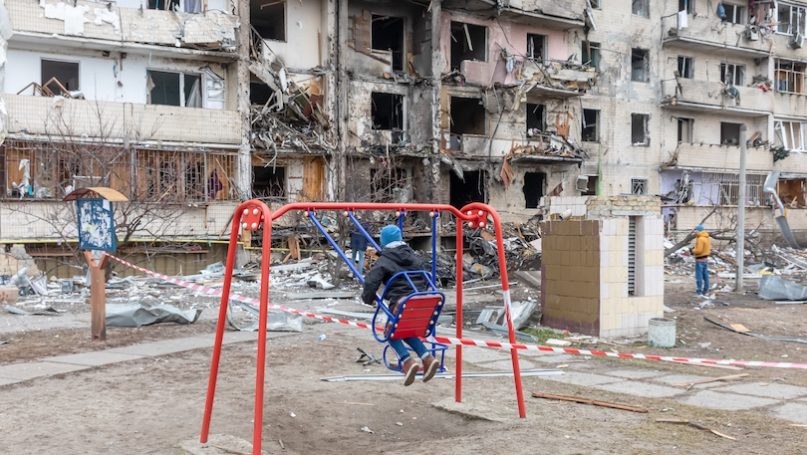David R. Marples

The Russian attack on Ukraine continues remorselessly as cities in the Donbas gradually succumb to the invasion forces. Today Severedonetk and Lysychansk, tomorrow Sloviansk. But what follows? Is there any logical conclusion to this lengthy war? The pattern of the war is notable. It began with fundamental Russian miscalculations about capturing the city of Kyiv and a change of government. The result was significant Russian losses, Russian atrocities in Bucha and other settlements, and a humiliating retreat over the border into Belarus to regroup.
In the south, Russian forces occupied Kherson region, including its main city, and advanced into Zaporizhzhia, and capturing Europe’s largest nuclear power plant. Though the local population was cowed, it showed signs of resistance and protests. Just as in the northern Kyiv region, it was plain that there was no support in Ukraine for the Russian invaders. The second phase of the war began in the only area that merited consideration, namely the Donbas, where two separatist regimes have remained in control of its eastern regions since the spring of 2014. Though some pro-Russian sentiment existed prior to the start of the current war, it was never overwhelming and the quasi regimes have remained in power through a combination of force, intimidation, and Russian backing.
In the current campaign, the larger of the two regimes, the so-called Donetsk People’s Republic, has suffered a casualty rate of over 50%, as new conscripts were sent into battle without adequate training or preparation. The next target for Russia is the city of Sloviansk, which was briefly the centre of the separatist forces and their Russian leader Igor Girkin in the summer of 2014. Its recapture was the most notable success of Ukraine’s Anti-Terrorist Operation launched by Acting President Oleksandr Turchynov. In short, Russia will derive satisfaction from its reconquest.
But, the key question is where Russia will go next? Will it continue to advance toward major cities such as Zaporizhzhia, Kharkiv, and Dnipro? Or will it be satiated with the capture of the entire Donbas, one of the initial declared goals of Vladimir Putin? The temptation for Putin will be to continue the advance. But the longer the war continues, the more dangerous becomes the situation for the Russian Army. Ukraine continues to receive advanced military equipment from the United States and Europe and maintains its preponderant international support.
An analogy for Putin to consider is the State of Israel in its wars with Arab states that followed its creation in 1948. Each time Egypt, Syria, Jordan, and other states, attacked Israel, they faced more advanced weaponry, and it was a matter of time before the Israelis were far too powerful for future assaults to succeed. In the same way, Ukraine could soon boast one of the best equipped armies in the world, capable not only of halting new Russian assaults, but also of regaining its lost territories in the Donbas and in the south.
Conversely, it is hard to fathom how Russia can maintain its armies in the field indefinitely given its rash use of missiles and manpower, and lack of outside support. Western sanctions and loss of energy revenues will slow down its economy considerably. Further, Russia’s war goals amount to little more than conquest and obliteration, backed by propaganda that appeals to the former empire and past leaders. Its leaders appear to be lost in a time warp, oblivious to the fact that the end of the Soviet Union brought new national aspirations for states like Ukraine, Moldova, or Georgia.
However, one should be wary of holding up Ukraine as a model state prior to the outbreak of war. Its independence period was tempestuous with two major national uprisings, widespread corruption, clan rivalries in major cities, and four years of chaotic Donbas-led government between 2010–14. It was not a safe place for journalists and its parliament was controlled by oligarchs. Far-right groups, though considerably less numerous than those in Russia, were a familiar sight, marching in armed formations through cities, breaking up Roma camps, or attacking LGBT parades. Regional divides were also difficult to manage as successive elections divided the country roughly between the west/centre and east/south.
Nevertheless, given a choice between rule by local oligarchs and a foreign occupant, the former was preferred by a large majority. And in 2019, the neophyte presidential candidate Volodymyr Zelensky received support from all parts of the country. His brief prewar presidency was not a great success but once Russia attacked, he showed remarkable skill in unifying the country and defying the Kremlin.
In short, Ukraine could emerge from the war stronger, more united, and irrevocably linked to the West rather than Russia. EU and NATO membership would become more feasible. It could herald a new beginning for the state, particularly with Western support and with its territories secured. In other words, it is in Ukraine’s best interests to keep fighting and refuse to concede land in the knowledge that the tide of war will eventually change in its favor.
After the conquest of the Ukrainian Donbas it would make sense for Putin’s Russia to try to reach an armistice – perhaps mediated by Turkey, Germany, France, or even China. But whether such logic permeates the Security Council is unknown. Russia seems blinded by its own propaganda and buoyed by its gains in Ukraine, costly as they have been.
No comments:
Post a Comment